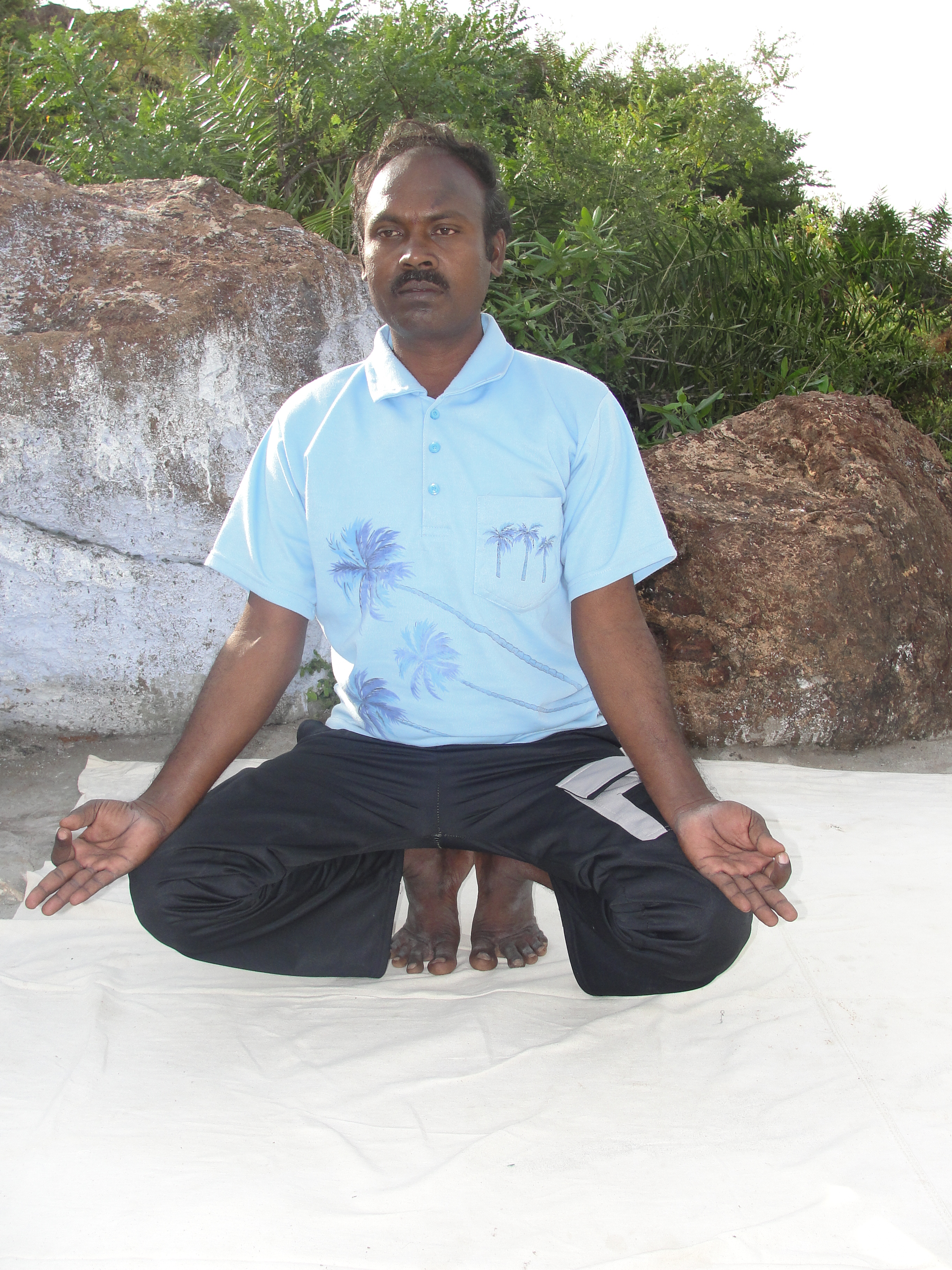Gorakshasana on:
[Wikipedia]
[Google]
[Amazon]

 Gorakshasana (, , Cowherd pose) is a seated
Gorakshasana (, , Cowherd pose) is a seated
 Gorakshasana (, , Cowherd pose) is a seated
Gorakshasana (, , Cowherd pose) is a seated asana
An āsana (Sanskrit: आसन) is a body posture, originally and still a general term for a sitting meditation pose,Verse 46, chapter II, "Patanjali Yoga sutras" by Swami Prabhavananda, published by the Sri Ramakrishna Math p. 111 and late ...
in hatha yoga
Hatha yoga (; Sanskrit हठयोग, International Alphabet of Sanskrit Transliteration, IAST: ''haṭhayoga'') is a branch of yoga that uses physical techniques to try to preserve and channel vital force or energy. The Sanskrit word ह� ...
. It has been used for meditation
Meditation is a practice in which an individual uses a technique to train attention and awareness and detach from reflexive, "discursive thinking", achieving a mentally clear and emotionally calm and stable state, while not judging the meditat ...
and in tantric practice.
Etymology and origins
The pose is named for the sageGorakhnath
Gorakhnath (also known as Gorakshanath (Sanskrit: ''Gorakṣanātha'') (Devanagari : गोरक्षनाथ / गोरखनाथ), c. early 11th century) was a Hindu yogi, mahasiddha and saint who was the founder of the Nath Hindu monas ...
, founder of the nath
Natha, also called Nath (), are a Shaivism, Shaiva sub-tradition within Hinduism in India and Nepal. A medieval movement, it combined ideas from Buddhism, Shaivism, Tantra and Yoga traditions of the Indian subcontinent.
yoga tradition, who is said to have used the pose for meditation
Meditation is a practice in which an individual uses a technique to train attention and awareness and detach from reflexive, "discursive thinking", achieving a mentally clear and emotionally calm and stable state, while not judging the meditat ...
. It is accordingly practised by his tantric devotees, the kanphata yogis. It is said to awaken kundalini
In Hinduism, kundalini (, ) is a form of divine feminine energy (or ''Shakti'') believed to be located at the base of the spine, in the '' muladhara''. It is an important concept in Śhaiva Tantra, where it is believed to be a force or power ...
and to halt the process of aging. The Sanskrit word () means "posture" or "seat".
Gorakshasana is medieval in origin, described in hatha yoga
Hatha yoga (; Sanskrit हठयोग, International Alphabet of Sanskrit Transliteration, IAST: ''haṭhayoga'') is a branch of yoga that uses physical techniques to try to preserve and channel vital force or energy. The Sanskrit word ह� ...
texts including the 14th century ''Shiva Samhita
''Shiva Samhita'' (IAST: śivasaṃhitā, also ''Siva Samhita'', meaning "Shiva's Compendium") is a Sanskrit text on yoga, written by an unknown author. The text is addressed by the Hindu ascetic Shiva to his consort Parvati. The text consists o ...
'' 3.108-112, the 15th century ''Hatha Yoga Pradipika
The ''Haṭha Yoga Pradīpikā'' ( or Light on Hatha Yoga) is a classic fifteenth-century Sanskrit manual on haṭha yoga, written by Svātmārāma, who connects the teaching's lineage to Matsyendranath of the Nathas. It is among the most infl ...
'' 1.28-29, and the 17th century ''Gheranda Samhita
''Gheranda Samhita'' (IAST: gheraṇḍasaṁhitā, घेरंडसंहिता, meaning “Gheranda's collection”) is a Sanskrit text of Yoga in Hinduism. It is one of the three classic texts of hatha yoga (the other two being the '' ...
'' 2.24.
Description
Gorakshāsana is a seated pose with the soles of the feet pressed together and the knees on the ground, as inBaddha Konasana
Baddha Konasana (; IAST: ), Bound Angle Pose, Butterfly Pose, or Cobbler's Pose (after the typical sitting position of Indian cobblers when they work), and historically called Bhadrasana, Throne Pose, is a seated asana in hatha yoga and modern yog ...
(in medieval times known as Bhadrasana), with the difference that the heels are under the body.
Variations
The pose is sometimes described as having the toes on the ground with the heels directly above them, as in Mulabandhasana. The ''Hatha Yoga Pradipika'' directs the yogin to "place the ankles under the scrotum on either side of the perineal seam, with the left ankle on the left and the right ankle on the right. Take hold of the sides of the feet firmly and steadily with both hands." It claims that the pose destroys all diseases.Other poses with the same name
The name Gorakshasana is given to a different balancing pose inB. K. S. Iyengar
Bellur Krishnamachar Sundararaja Iyengar (14 December 1918 – 20 August 2014) was an Indian teacher of yoga and author. He is the founder of the style of yoga as exercise, known as " Iyengar Yoga", and was considered one of the foremost yoga ...
's 1966 ''Light on Yoga
''Light on Yoga: Yoga Dipika'' (Sanskrit: योग दीपिका, "Yoga Dīpikā") is a 1966 book on the Iyengar Yoga style of modern yoga as exercise by B. K. S. Iyengar, first published in English. It describes more than 200 yoga postu ...
'', where the legs are folded as in Padmasana with the knees only on the ground, the hips directly above the knees, and the hands in prayer position. Iyengar describes it as "a difficult balancing pose and one is elated even if one can only balance for a few seconds."
References
External links
* {{Hatha yoga Sitting asanas Medieval Hatha Yoga asanas Meditation asanas